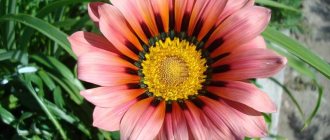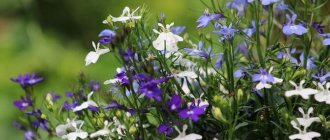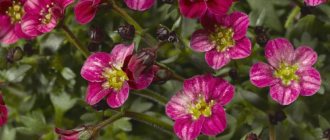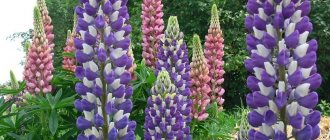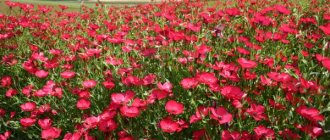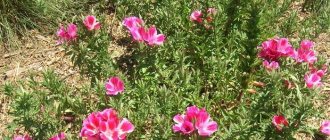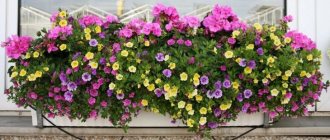Godetia is a plant crop that is used to improve summer cottages and garden plots.
Any novice gardener, whose knowledge about plants is kept to a minimum, can grow Godetia. To obtain a productive result, you will need to comply with sowing dates, rules for growing seedlings and subsequent care of Godetia Dear readers! For you, we have created communities on social networks in which useful articles and interesting ideas are published several times a day! Subscribe and receive useful content in a convenient format!
How to determine the sowing time of Godetia
Plant seeds are planted when warm days arrive. Small cold snaps are possible, which will only harden Godetia. In regions with a harsh climate, planting is carried out after the soil has completely warmed up and the air temperature has normalized. Flower crops are mainly planted in the spring, but some gardeners practice autumn planting in regions with warm climates.
Godetia varieties, which one is better to choose
Godetia grandiflora
Most often, gardeners grow two types of Godetia: Large-flowered and Pleasant. Large-flowered is distinguished by large inflorescences and a pink hue. This subspecies can reach a length of 30 cm. Popular varieties of Large-flowered Godetia are:
- Sweet summer.
- Memory
- Orange room.
Godetia Pleasant is distinguished by alternately arranged linear leaves. The height of the crop reaches 60 cm. The inflorescences themselves are of medium size and have a velvety surface of the petals. This subspecies blooms almost continuously from July to September. Popular varieties of Pleasant Godetia are Satin, Pink Grace.
Lovely
In appearance, this godetia fully corresponds to its name. Planting and caring for it are, again, usual for the species. You just need to take into account that the Lovely Godetia grows up to 60 cm, its bushes are slender but lush. Therefore, when planting, the flower must be given enough space. Its flowers are not very large, only 5-5.5 cm in diameter, but there are a lot of them on the bush, which always looks impressive. The petals are slightly widened along the edge, wavy or smooth, shiny. Their shades range from red to lilac. Godetia the Charming is good both in flower beds and in bouquets. It blooms until frost and produces a lot of seeds. Their germination lasts up to 3 years.
When to plant depending on the region
The timing of planting seeds to grow seedlings can vary significantly depending on what region of the country the gardener lives in.
In Moscow and Moscow region
In Moscow and the region, you can plant flowers in mid-late April, when the soil warms up to 15 degrees.
In the middle zone
In the regions of Central Russia, Godetia is planted for further cultivation in May-June.
In the Urals
Seed material is pre-planted in boxes in early March, and only after the soil has completely warmed up (by mid-June) is the crop transplanted into open ground for further cultivation.
In Siberia
In Siberian conditions, it is also prohibited to plant the plant directly in open ground. Initially, it is placed in small pots in mid-March, and then the crop is planted in open ground in May-June.
In the Leningrad region
When grown in the Leningrad region, Godetia can be planted in late April / early May.
Planting Godetia with seeds step by step
How to plant godetia seedlings when growing at home:
- Prepare and disinfect the container for sowing.
- Place a drainage layer on the bottom of the vessel and pour loose soil on top.
- Add a little sand on top and smooth it over the surface.
- Place the seeds in the ground.
- Sprinkle them with a small amount of soil.
IMPORTANT! To retain moisture and heat, the planting containers will need to be covered with plastic wrap.
Features of reproduction
Godetia is an annual plant, therefore it reproduces in only one way - by seeds. It is not necessary to buy them every time, since seed material can be prepared independently. Subject to certain conditions, its germination persists for 3-4 years.
Only ripened seeds need to be collected. To do this, you need to wait about a month after flowering. When the boxes begin to darken, you should carefully cut them off and dry them. After this, you can shake out the seeds.
Attention! To preserve the germination of godetia seeds, they must be stored in a dark and cool place. High humidity is destructive.
How to plant Godetia in peat tablets?
To plant seeds in peat tablets you will need:
- Prepare a suitable large container. You need to focus on plastic vessels with high sides.
- Place peat tablets in a row at the bottom of the vessel.
- Pour some warm water to cover the bottom of the container.
- Leave the peat discs for 10 minutes to swell.
- Remove the tablets and discard the remaining water from the container.
- Place seed material one by one into the recess of the washer.
If the washers are small, you can use a toothpick to plant the seeds.
How to care for Godetia seedlings, what are the tricks?
Godetia seedlings require careful care. Therefore, the gardener will need to follow the rules of watering, fertilizing, and lighting.
The seeds of Godetia have sprouted, what to do next?
After the seeds germinate, you will need to monitor the lighting and watering of the crop. Seedlings should be stored in a well-lit place with an acceptable level of humidity. The gardener must take care that when growing the flower there are no strong drafts. Any exposure to cold air masses can lead to the death of the crop.
Watering should be regular but moderate. In order not to overdo it with water, it is recommended to use a spray bottle for these purposes. It will help not only nourish the root system, but also moisturize the stems and leaves of the plant. It is better to water the flower 3-4 times a week.
IMPORTANT! If the soil does not have time to dry out between irrigations, then it is better to skip 1-2 waterings and wait until it dries completely. Otherwise, the plant may be subject to rot.
How to feed Godetia seedlings?
It is worth feeding seedlings infrequently - 1-2 times a month. In the future, when growing flowers, when the flowering period begins, the frequency of procedures can be increased to 1 time in 10 days. The choice of fertilizer depends on the type of soil in which the crop grows. Most often, complex or mineral fertilizers are used.
Rules for picking Godetia
2 weeks after the first shoots of the plant appear, you can remove the plastic film. If the first leaves have already formed on the plant, you can start picking. To carry it out, you will need to prepare a soil mixture and a sterilized container. How to carry out the procedure step by step:
- Using a small shovel, place the seedlings on a flat surface.
- Separate seedlings that are entangled with each other.
- Trim the roots of Godetia by 2 cm. This procedure stimulates the growth of new shoots.
- Plant seedlings in larger containers.
During the process, the same soil composition is used as during planting.
Care
Godetia loves moderate watering with warm water up to the root of the bush, especially in hot weather.
For abundant flowering, it is advisable to feed the plants every 10–14 days with a solution of complete mineral fertilizer with microelements.
Suitable for godetia nitrophoska with a predominance of potassium and phosphorus, in the amount of 30 g of powder per bucket of water. The solution consumption rate is approximately 100 ml per plant.
Faded buds need to be removed - this will allow the plant not to waste energy on producing seeds. Under tall forms, you need to place supports in time to prevent the plants from falling over.
Tall plants are given additional support to which they are tied.
When to plant seedlings in open ground?
You can replant flowers in open soil after they have grown sufficiently and the ground has warmed up to 15-18 degrees. This is approximately May-June (for the Urals and Siberia). If the gardener has doubts about the readiness of the seedlings for transplanting, then you can measure its height using a ruler. If the readings exceed 6 cm, then it’s time to plant Godetia in a permanent place. If the stem height is still small, you should wait a few more weeks to replant.
For transplantation, choose a sunny area that is protected from drafts. It is recommended to plant the flower in places where weeds grow to a lesser extent. Otherwise, at the first rain, they will begin to grow abundantly and interfere with the full development of Godetia. Planting is carried out in previously prepared and loosened soil. It will also need to be mixed with sand and peat.
IMPORTANT! The owners will need to make small holes at a distance of 20-25 cm from each other, plant seedlings in them, compact the soil and water the plant generously.
Beauty formula
Like any representative of the flora, godetia belongs to a specific family. This annual flower belongs to the fireweed family. She is a relative of the well-known medicinal Ivan tea. The genus Godetia includes about twenty species found throughout America. The plant originates from southern California. It is named after the botanist Godet, who first “tamed” this marvelous flower, studied it and included it in the classification.
It has an erect stem that branches from the base and barely reaches 40 centimeters in height. The bushes are spreading, the crown is pyramidal. Leaves lanceolate, alternate. Nothing remarkable, just like many other flowers. The most magnificent thing about godetia is the flowers. The shape of the petals, their delicate silky texture, the most delicate color, like a hint of color - this is the beauty formula by which nature created this plant. Godetia flowers are not just large, but very large. They can reach 10 centimeters in diameter in a certain variety. Godetia has very short peduncles. The flowers appear as if attached directly to the leaves or stems. They are shaped like a bell or form a cup.
Godetia flowers are not just large, but very large
After flowering, a fruit is formed - a seed capsule with four sides. The seeds in them are not very small, and their germination persists for four years.
Today, various godetia hybrids have been developed:
- azalea;
- bushy;
- dwarf;
- terry.
Despite the delicate appearance of its graceful flowers, godetia can bloom all summer and autumn until frost, easily overcoming all the difficulties associated with summer drought, autumn rains and temperature changes.
Godetia blooms until frost
Answers to constant questions
Below are the most popular questions from novice gardeners who decided to improve their plot with Godetia.
What soil should I buy for growing seedlings?
It is recommended to use ready-made flower soil combination kits, sold in hardware stores. You can also make your own mixture for planting. To do this, you need to combine loose soil with a mixture of peat and a small amount of sand. Mix all components and use as intended.
How can you stimulate seeds for further growth?
You can stimulate the seeds with ready-made solutions (for example, Energen for garden crops or potassium permanganate) or use organic means - ash, onion peel tincture, honey solution.
Why don't the seeds germinate?
Lack of growth indicates the following reasons:
- Incorrect landing technique.
- Lack of watering or excessive watering.
- Lack of fertilizing.
- Using unsuitable fertilizers.
- Lack of good lighting.
Also, poor seedling growth may indicate unsuitable soil for Godetia.
Why are seeds soaked?
Soaking is necessary to soften the outer shell of the seeds, remove essential oils (which slow down growth) and disinfect the planting material. There is no need to soak only those seeds that were purchased in stores. Most likely, they have already been processed at the enterprise.
How to harden Godetia?
Hardening is used 1-2 weeks before planting seedlings in open ground. To do this, you need to take it out into the open air every day, gradually increasing the amount of time spent in it.
What to do if Godetia seedlings do not grow?
It is necessary to loosen the soil and look at the condition of the stem. Perhaps it began to rot from excessive watering or, on the contrary, to dry out due to lack of moisture. You should also feed the plant with mineral fertilizer, which stimulates shoot growth. The reason may lie in the lack of light. Then you will need to move the pot for growing strong seedlings to a more illuminated part of the house.
Pests and diseases
The most common problems with Godetia Monarch are associated with the following diseases:
- Blackleg (root rot) is caused by a fungus that actively develops in a humid environment. The root turns black and begins to die. Diseased plants must be immediately removed and burned to avoid contamination of neighboring crops.
If the humidity is too high, a fungus develops, causing root rot (blackleg). - Downy mildew (downy mildew), diseased bushes are stunted in growth, the stems become thinner, and a white coating appears on the back of the leaves.
Downy mildew or downy mildew is easily recognized by the white coating on the leaves
Fungicides Alirin-B, Baktofit and the like help well in the fight against these ailments. Many gardeners use Bordeaux mixture, copper sulfate and colloidal sulfur.
The most important enemy of Godetia Monarch is aphids. Insects form giant colonies and can quickly destroy the plant. Aphids prefer very young shoots, buds and leaves, which is especially dangerous.
Aphids form huge colonies and prefer to feed on young parts of the plant.
Folk remedies have proven their effectiveness against insects. These include spraying with soap or ash. Infusions of garlic, onions, citrus fruits, chamomile or dandelions will also be effective.
